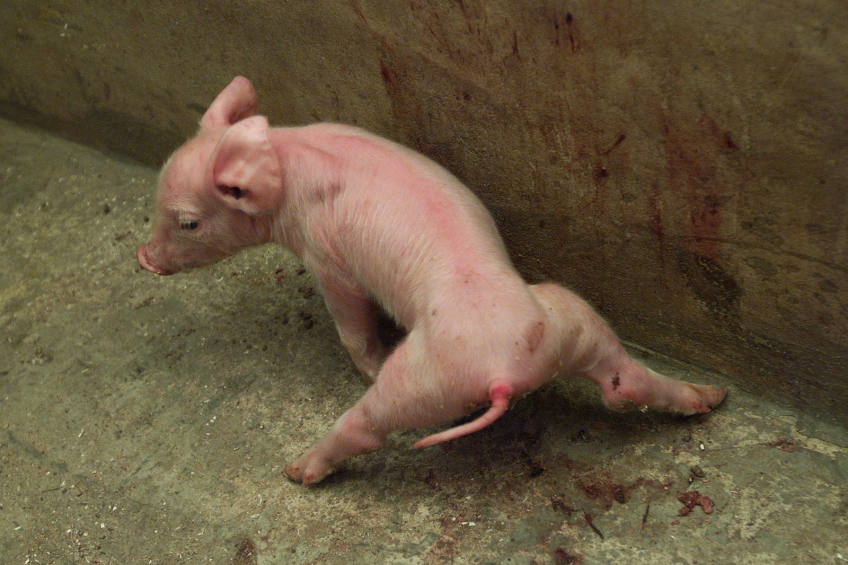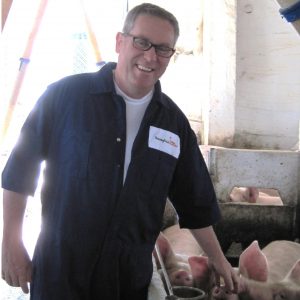Major problems in piglet health and management

They say a good start is half the battle. There is no better way to emphasise the importance of keeping piglets healthy from day one. This article helps to identify the five most common health problems in piglets.
A newborn litter of piglets is often the focus of interest in normal farrowings. Most farms routinely collect data on the numbers of piglets born alive and dead, as this will have a major impact on farm profitability and breeding programmes. All farms should develop and monitor targets for reduction of piglet deaths prior to weaning, aiming for a target of less than 10% in each litter. When looking at piglet data, it is important to properly record the status of piglets at birth. Most sows give birth at night and if staff activity is low, then many litters may only be examined several hours after the birth has finished.
It is therefore possible that young piglets were born alive and healthy, but have been killed or crushed by the sow, at some time after their birth. So staff may mis-classify these dead piglet cases as pre-parturition stillborn deaths, rather than the correct diagnosis of neonatal piglet death.
Stillborn piglets are recognised by the presence of dried mucus over the body and soft un-worn hooves.
The largest category of neonatal piglet deaths in normal farm situations is often that of a piglet in good body condition that is found dead in the first few days of its life. The death of these piglets is usually due to suffocation from being overlain by the sow.
The other main problems are chilling, failure of colostrum intake, diarrhoea and birth defects.
1 Overlay
This is a common problem affecting modern lines of pig breeds on many farms. The farmer may notice pre-weaning mortality of young piglets consistently above 15% of some litters. Close inspection will indicate that piglets become crushed and killed underneath the abdomen or legs of the sows. Occasionally, a live piglet is discovered squealing loudly underneath a sow.
Most affected piglets are only one to three days of age. The widespread usage of crates or cradle devices that restrain the sow during farrowing and lactation, which were first adopted in the 1960s, lead to a marked reduction in this form of piglet death.
However, even when farrowing cradles are used, it can still be a major problem. In farms that use open farrowing areas, without any form of sow restraint device, then piglet deaths due to overlay can be much higher.
There are undoubtedly some sows that are clumsy and liable to wander about and flop down, without care for the piglets. These sows should be identified by farm records and culled. However, most overlay cases are due to various factors within the farrowing areas. The worst affected litters can be with fat sows in older farrowing pens. If the sows are too fat, then they are less active and more likely to drop to the ground suddenly, perhaps with a piglet underneath.
The problem is also worse if staff fill the feed troughs of the sows by hand in a morning rush-hour period, which may lead to many excitable sows jumping up and down, with piglets underneath. The problem is exacerbated by slippery floors, which make it difficult for the sow to lie down or get up easily. Heating devices need to be carefully managed, to prevent piglets sleeping too close to the sow.
2 Chilling
Chilling is a common problem on farms with poor management of the farrowing rooms. Piglet chilling is often seen during the first months of colder winter weather. Affected piglets are young, weak, slow-moving and tend to huddle in groups, often near to the sow’s udder. The piglets are cold to the touch and the floors of the farrowing pens also feel cold and damp. Affected piglets may lie down on their side and die in a dull coma.
Piglets are born out of the warm environment of the uterus directly into the cold and wet environment of the farrowing area.
Newly born piglets do not have much innate heat capacity or energy reserves. Therefore the farrowing room management must provide adequate heating, with a room temperature of 20oC and a brighter section, heated to at least 35oC, to provide a safe and warm space for the piglets to sleep away from the sow. Piglet chilling will occur if the farrowing pens are draughty and the floors are cold and damp.
When piglets become chilled, they will move towards the sow to try to stay warm and may suffer more from overlay injuries.
The farrowing areas need to have adequate building maintenance with no door, curtain or window draughts, with pens containing suitable sleeping areas, active heat lamps and warm, dry floors. This is particularly important in regions with cold weather periods.
Many farms use bedding materials and mats to assist the piglets find a warm and dry sleeping area.
3 Failure of colostrum intake
Unlike in dogs and humans, there is no transfer of any protective materials through the placental membranes in foetal pigs. The piglet is therefore born ‘naked’ and requires an immediate intake of these protective materials, such as cells and antibodies, contained in the first milk of the sow, or colostrum. The colostrum should be yellow and creamy and produced for the first day of lactation. If there is insufficient intake of colostrum, then the farmer may notice increased numbers of sick piglets.
Affected piglets are dull and walking in a weak manner. These piglets appear cold, shivering, with poor breathing and blue extremities. They do not eat readily, huddle in groups and may die. This condition is often a form of Escherichia coli blood poisoning in young piglets, known as coli-septicaemia. E. coli are common bacteria in the farm environment especially ones with a busy number of farrowings and poor hygiene. Coli-septicaemia occurs when there is insufficient intake of colostrum by the newly born piglets, with a reduction in blood levels of antibodies needed to fight these environmental bacteria. Coli-septicaemia may coincide with other farrowing house problems such as low milk production or mastitis in sows.
The management of farrowing areas requires sufficient staff to assist newborn piglets to suckle colostrum, including those born during night time hours. The udders of gilts and sows should be cleaned regularly. Farrowing areas will be a reservoir of infection and cleaning must include the use of detergents to remove the fatty areas derived from sow milk.
4 Diarrhoea
Bacterial diarrhoea among neonatal piglets (baby pig scours) is frequent, if there is an incomplete vaccination programme for the breeding pigs. Diarrhoea problems can appear to spread around litters in the farrowing areas. The affected piglets are generally one to seven days-old, with watery white-yellow diarrhoea, ejected as a stream from the anus. At autopsy of affected piglets, will be dehydration with a loss of fat reserves, with dilation of the intestines by watery contents. This type of diarrhoea in young piglets is most suggestive of the common form of neonatal colibacillosis in piglets, caused by enterotoxigenic strains of Escherichia coli (ETEC). These ETEC are located in the farrowing pen environment and are ingested by the piglet soon after birth. The bacteria then attach to the intestines and cause an outpouring of fluid into the intestine and diarrhoea.
Affected piglets may be treated with oral antibiotics and re-hydration electrolytes to replace body fluids.
It is important to limit the spread of the ETEC around the farrowing rooms. Handling of affected piglets should be done after normal ones, with separate boots and clothes.
Vaccines against ETEC are widely used in pregnant gilts and sows to raise protective immunity and antibody levels, which are transferred to piglets via the colostrum. Some authorities also recommend the procedure of feeding faecal materials to the gilts in late gestation (feedback). This faecal material may be diarrhoea from affected piglets collected on toilet paper.
In older piglets, the main cause of scours is coccidiosis. Coccidia are microscopic parasites that pass eggs (known as oocysts) in the piglet faeces onto the floor of the farrowing pens. The oocysts develop into infective stages, so piglets in the contaminated pen will take in these oocysts shortly after birth.
The coccidia then develop and cause damage to the lining of the intestine, often when piglets are around two weeks-old.
The faeces of the affected piglets are soft, pasty and grey to yellow, resembling toothpaste. The main effect is a reduction in weaning weights of the piglets. Individual litters and piglets affected with coccidiosis may be treated with oral sulfa antibiotics.
For prevention, the potent anti-coccidial drug toltrazuril is recommended as a single oral dose at three to four days-old, to disrupt the life cycle of the parasite.
5 Birth defects
A range of inherited birth defects may occur in newborn piglets. In the reproductive tract, some male piglets may appear to only have one testicle in their scrotum, with the other testicle remaining inside the abdomen. This condition is known as a cryptorchid piglet.
Secondly, some female piglets may appear to only have very small vulvas and few teats. At autopsy, their internal uterus and ovary are also tiny and difficult to locate. This condition is known as intersex, or hermaphroditism. Cryptorchid and intersex defects are reasonably common among pigs. They can be disruptive to breeding programmes, if the pigs are left intact in the breeding herd.
A third form of birth defect may be noticed during the physical castration process, where some male piglets appear to have portions of their intestines mixed in with the testicles. This condition is known as inguinal or scrotal hernia. It is a common inherited defect of pigs, with a suggested incidence of up to 1% of piglets. If a hernia bulge is evident in either scrotal area, that pig should not be castrated in the normal fashion. The correct surgical repair of inguinal hernia in male piglets requires that the testicle area be opened and the testicle tunic be twisted and sutured while twisted, so that the intestinal contents are returned to the abdomen and held there.
Another common form of birth defect (particularly in Landrace pigs) is small piglets with weak splay-legs. The most common sign is the back legs splayed out sideways and forwards, causing the piglet great difficulty in standing up on its hind legs. The pre-weaning mortality rate is increased, because piglets cannot suckle properly or avoid being overlain by the sow. These piglets are born with a leg muscle weakness and need assistance from farm workers to reach the teats and suckle. The hind legs can be tied loosely together above the ankle hocks with lightweight plastic tape. If the piglet survives five days, then the tapes can be removed, the hind legs gradually become stronger and recovery can occur.
A further inherited defect known as congenital tremors, is seen in lines of Landrace or Saddleback breeds.
Many young piglets are visibly shaking and trembling, when standing and walking about. They have difficulty standing upright and getting to the teats. The tremors cease when the piglets are sleeping. The pre-weaning mortality rates are increased in these litters, with many affected piglets suffering starvation or overlay. Congenital tremors involve a degeneration in the part of the piglet brain, known as the cerebellum, responsible for balance and muscle control.
A wide range of other congenital defects have been reported in piglets, such as skin defects, but these will vary in prevalence and fade away if the affected lines of pigs are side-lined. The main control measure for all birth defects is simply to note and avoid the particular mating combination of these pigs, which produced these defects.
[Source: Pig Progress special Piglet Health, 2014]











